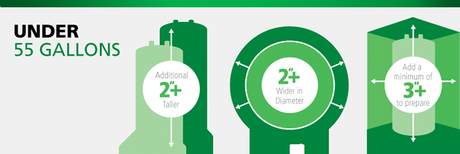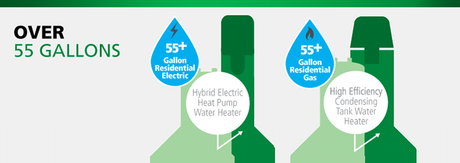On April 16th of this year, new energy efficiency standards from the National Appliance Energy Conservation Act (NAECA) go into effect for water heaters. Starting that day, manufacturers will only be allowed to make water heaters that conform to the new energy standards. Existing water heaters will still be allowed to be sold, but I don’t expect that supply to last for more than a few months. Here’s how the changes will affect homeowners.
Side note: don’t call it a “hot water heater”. It’s just a water heater.
Water heaters under 55 gallons will need to have their energy efficiency rating bumped up just a tad. To do this, manufacturers will be adding about an inch of insulation to the water heater tank. This will increase the diameter of same-capacity water heaters by over two inches, and will increase the height by about one to two inches.
This increase in size won’t be a big deal for most people, but if the water heater is squeezed into a tight space, replacing the water heater could be a hassle, or possibly require replacement with a smaller unit. The diagram below comes from AO Smith’s web site.

Gas water heaters over 55 gallons will need to have an energy factor of at least .74 to .75, depending on the exact size. To achieve this modest energy factor increase, it’s expected that manufacturers will only produce condensing water heaters for these larger sizes. That means a powervent water heater, which needs to have its own dedicated exhaust vent, a power source, and a way to dispose of condensate. These water heaters are obviously more expensive, and the installation costs will be higher too.
Electric water heaters over 55 gallons are about to get silly. For these units, the energy factor is going to more than double. To get there, you’ll be looking at a heat pump water heater. Never seen one? I haven’t either.
A heat pump water heater works by extracting heat from the air and transferring it to the water in the tank. Of course, this means it’ll act like an air conditioner in the home. How much will this cool the space it’s in? I don’t know yet, but I’ve heard it’s fairly significant. Here’s a nice little video clip from GE showing the amount of energy that these units have the potential to save:
Besides a change in technology, heat pump water heaters will also be significantly taller; somewhere around 18”.

These new units will obviously be more expensive, but the installation / replacement costs should remain the same.
Tankless water heaters won’t change much. The energy factor for gas fired tankless water heaters will be going up from .62 to .82, but the vast majority of tankless water heaters produced today already exceed the new energy standard. The energy factor for tankless electric water heaters will remain the same.
Click on any of the links below for more information and specific details on the new water heater standards:
- AO Smith
- US Department of Energy
- Bradford White
- Rheem
Author: Reuben Saltzman, Structure Tech Home Inspections
![]()
![]()

![]()



